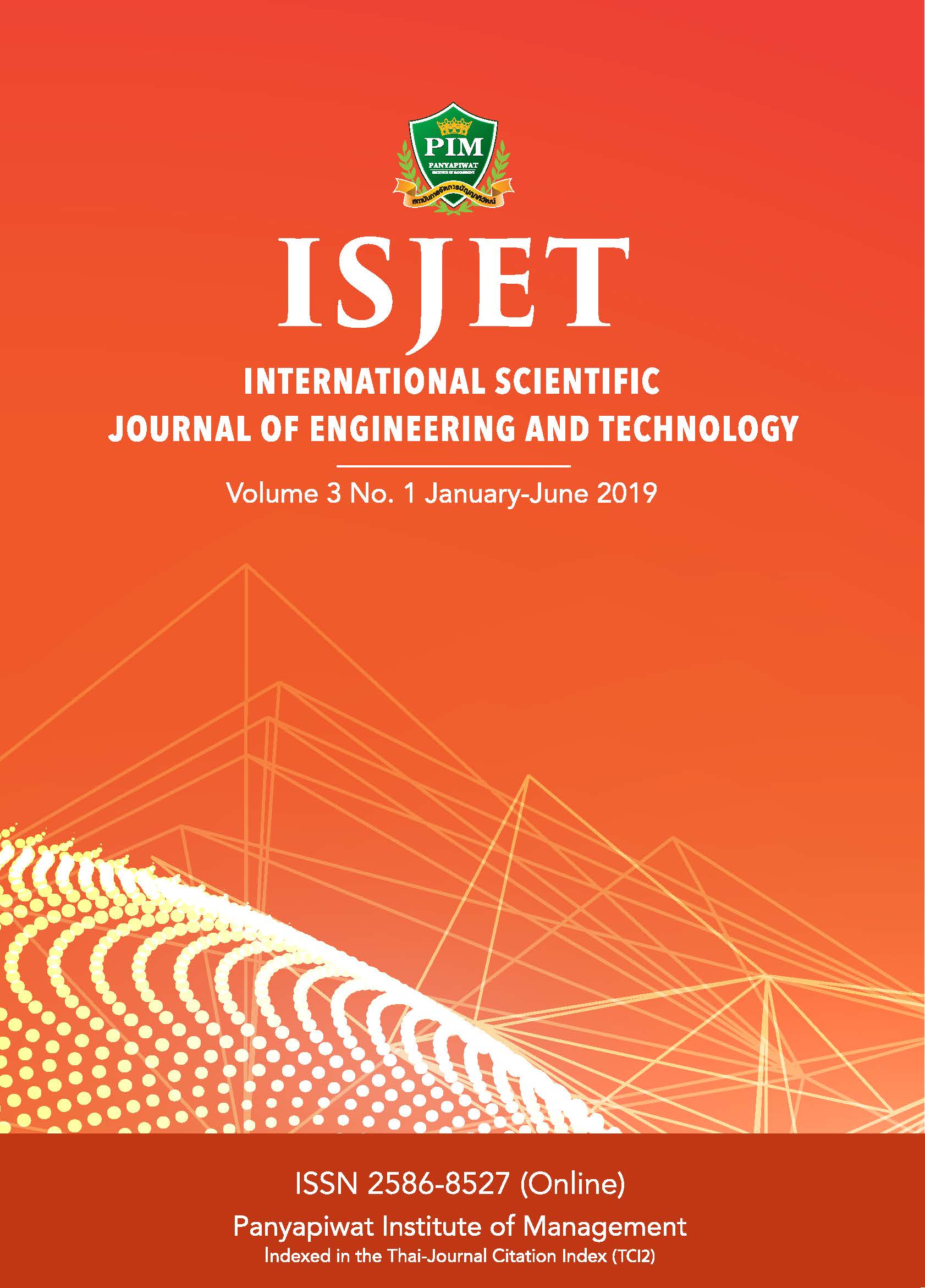Capacity Planning of Aggregators and Multi-objective Optimization Approach to Optimal Data Transmission in Cloud Providers for Meteorological Sensor Network
Main Article Content
Abstract
To predict weather precisely, meteorologists need to collect and analyze meteorological data from wireless sensor devices installed in different areas. Today, cloud computing provides efficient storage and processing tasks for large-scaled sensor data. However, wireless sensors are constrained with bandwidth to transmit data to the cloud. Therefore, we propose a system model called cloud-based meteorological sensor network with aggregator approach which combines data from sensors and forwards to the cloud with better bandwidth. In this paper, the two main problems are considered for proposed system model. First, optimization approach to capacity planning of aggregators is addressed to obtain optimal number of aggregators for providing enough services to sensor data while reducing high investment. Second, optimal data transmission (ODT) algorithm based on multi-objective optimization approach is also proposed to minimize cost for provisioning resources and delay for transferring and processing when data from aggregators are allocated to multiple cloud providers. Then, the extensive numerical studies are performed for each problem. The numerical
results provide not only optimal number of aggregators with the minimum total cost but also optimal data transmission from aggregators to the
cloud with the minimum total cost and delay for the proposed system model.
Article Details
เนื้อหาข้อมูล
References
for wireless sensor networks with push notifications and end-to-end connectivity. Mobile Information Systems. [Online].
10(1), pp. 19-35. Available: https://content.iospress.com/ journals/mobile-information-systems/10/1
[2] A. R. Syed, K. Gillela, and C. Venugopal. (2013, Jun.). The future revolution on big data. International Journal of
Advanced Research in Computer and Communication Engineering. [Online]. 2(6), pp. 2446-2451. Available:
https://www.ijarcce.com/upload/2013/june/44-Abdul%20Raheem-The%20Future%20Revolution%20on%20Big%20
Data.pdf
[3] R. Buyya, C. S. Yeo, S. Venugopal, J. Broberg, and I. Brandic. (2009, Jun.). Cloud computing and emerging IT platforms: Vision, hype, and reality for delivering computing as the 5th utility. Future Generation Computer Systems. [Online]. 25(6), pp. 599-616. Available: https://www.sciencedirect.com/science/article/pii/S0167739X08001957
[4] B. Sheng, Q. Li, and W. Mao. (2010, Oct.). Optimize storage placement in sensor networks. IEEE Transactions on Mobile Computing. [Online]. 9(10), pp. 1437-1450. Available: https://www.cs.wm.edu/~liqun/paper/mobihoc06.pdf
[5] A.-S. K. Pathan, C. S. Hong, and H.-W. Lee, “Smartening the environment using wireless sensor networks in a developing country,” in Proc. 8th International Conference Advanced Communication Technology, pp. 5-709.
[6] N. Shah, U. B. Desai, I. Das, S. N. Merchant, and S. S. Yadav. (2009, Jan.). In-field wireless sensor network (WSN) for estimating evapotranspiration and leaf wetness. International Agricultural Engineering Journal. [Online]. 18(3), pp. 43-51. Available: https://www.academia.edu/248698/IN-FIELD_WIRELESS_SENSOR_NETWORK_WSN_FOR_ESTIMATING_EVAPOTRANSPIRATION_AND_LEAF_WETNESS
[7] G. Virone, A. Wood, L. Selavo, Q. Cao, L Fang, T. Doan, Z. He, R. Stoleru, S. Lin, and J. A. Stankovic. (2006, Apr.).
An advanced wireless sensor network for health monitoring. Presented at Transdisciplinary Conference on Distributed
Diagnosis and Home Healthcare. [Online]. Available: https://pdfs.semanticscholar.org/3706/f2446de9ac8a466efdbdd8e0
fd1f358631a5.pdf
[8] A. Pascale, M. Nicoli, F. Deflorio, B. D. Chiara, and U. Spagnolini. (2012, Mar.). Wireless sensor networks for
traffic management and road safety. IET Intelligent Transport Systems. [Online]. 6(1), pp. 67-77. Available: https://citeseerx.ist.psu.edu/viewdoc/download?doi=10.1.1.338.4514&rep=rep1&type=pdf
[9] M. A. Hossain. (2014, May.). Framework for a cloud-based multimedia surveillance system. International Journal of
Distributed Sensor Networks. [Online]. 10, pp. 1-12. Available: https://www.researchgate.net/publication/273610620_
Framework_for_a_Cloud-Based_Multimedia_Surveillance_System
[10] F. Ahmad, M. Kazim, A. Adnane, and A. Awad. (2015, Dec.). Vehicular cloud networks: Architecture, applications and security issues. Presented at 8th IEEE/ACM International Conference on Utility and Cloud Computing. [Online].
Available: https://www.researchgate.net/publication/286624464_Vehicular_Cloud_Networks_Architecture_Applications_and_Security_Issues
[11] M. Fazio, A. Celesti, A. Puliafito, and M. Villari, “Big data storage in the cloud for smart environment monitoring,”
in Proc. Procedia CS, 2015, pp. 500-506.
[12] A. Ghasempour and J. H. Gunther. (2016, Jan.), “Finding the optimal number of aggregators in machine-to-machine advanced metering infrastructure architecture of smart grid based on cost, delay, and energy consumption,” in Proc.13th IEEE Annual Consumer Communications and Networking Conference, CCNC, 2016, pp. 960-963.
[13] S. J. Devi, G. S. S. Devi, and G. M. T. Selvan. (2013, Dec.). Wireless sensor network integrating with cloud computing for patient monitoring. International Journal of Engineering Sciences and Emerging Technologies (IJESET). [Online]. 6(3), pp. 316-323. Available: https://www.ijeset.com/media/0002/5N13-IJESET0603123-v6-iss3-316-323.pdf
[14] L. Hughes, X. Wang, and T. Chen. (2012, Nov.). A review of protocol implementations and energy efficient cross-layer design for wireless body area networks. Sensors (Basel). [Online]. 12(11), pp. 14730-14773. Available: https://www.ncbi.nlm.nih.gov/pmc/articles/PMC3522938/
[15] T. Azizi, R. Beghdad, and M. Oussalah, “Bandwidth assignment in a cluster-based wireless sensor network,”
in Proc. WCE, 2013, pp. 1-6.
[16] Zigbee Setting Standards for Energy-Efficient Control Networks. [Online]. Available: https://www.yumpu.com/
en/document/read/3733703/zigbee-setting-standards-forenergy-efficient-schneider-electric
[17] M. Satyanarayanan, P. Bahl, R. Caceres, and N. Davies, “The case for VM-based cloudlets in mobile computing,” IEEE Pervasive Computing, vol. 8, no. 4, pp. 14-23, 2009.
[18] A. L. Jaimes, S. Z. Mart´ınez, and C. A. C. Coello, “An introduction to multiobjective optimization techniques,”
in Optimization in Polymer Processing, A. Gaspar-cunha and J. A. Covas, Ed. UK: Nova Science Pub Inc, 2009, ch. 1,
pp. 29-57.
[19] GAMS Solvers. [Online]. Available: https://www.gams.com/help/index.jsp?topic=%2Fgams.doc%2Fsolvers%2Findex. html


